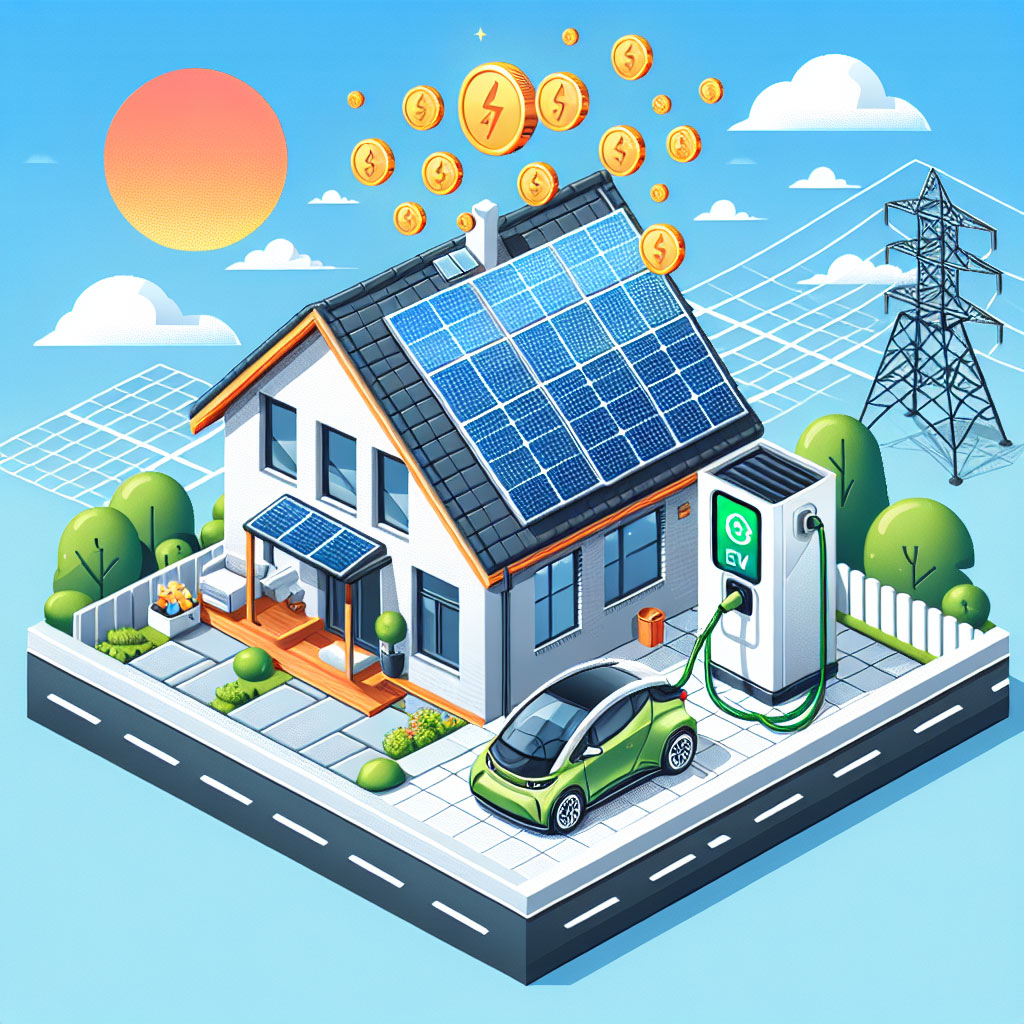
As more Australians switch to electric vehicles (EVs), homeowners are increasingly looking to pair EV charging with rooftop solar to cut running costs and reduce emissions. A solar EV charger – sometimes called a solar-aware or PV-integrated charger – directs surplus solar generation to charge an EV first, only drawing from the grid when necessary. This not only reduces household electricity bills but also increases self-consumption of solar energy at a time when feed-in tariffs are generally low across the country.
How it works – step by step
- Solar generation
Rooftop PV panels produce direct current (DC) electricity that a solar inverter converts to alternating current (AC) for use in the home. Generation peaks during daylight hours. - Energy monitoring
A monitoring device-commonly a current transformer (CT) clamp-measures real-time power flow at the switchboard or at the inverter. Some systems instead leverage the inverter’s API or built-in export limiter capabilities to determine surplus generation. - Smart charging control
The solar-aware charger receives data from the monitoring system and adjusts EV charging rates dynamically:
- Prioritise solar: When surplus solar is available, charging is ramped up to use that energy first.
- Modulate charge: Charging speed is reduced or paused when solar falls below the target level, resuming when generation increases or when the schedule demands.
- Fallback to grid: If solar isn’t sufficient to reach a set charge level or schedule, the charger can draw the necessary energy from the grid.
Optional battery integration
If a home battery is present, the system can charge the battery with excess solar and discharge it for EV charging when sunlight is not available, increasing self-consumption and resilience.
Key components and terminology
- Solar panels: The PV array that generates electricity.
- Solar inverter: Converts DC from panels to AC for household use; hybrid inverters can work with battery storage and manage export limits.
- Smart EV charger (EVSE): The wall unit that controls charging, often with app control and smart features.
- CT clamps / power meters: Sensors that measure the direction and magnitude of power flow to detect surplus.
- Home battery (optional): Stores excess solar for later use (e.g., for EV charging overnight).
- Communication protocols: OCPP (Open Charge Point Protocol) for charger management; ISO 15118 supports Plug & Charge and emerging vehicle-grid features.
Why Australians should consider a solar EV charger
- Lower running costs: With modest feed-in tariffs around the country, exporting surplus to the grid often pays less than using that same energy to charge an EV. Solar-aware charging increases self-consumption and reduces household bills.
- Reduced emissions: Charging from rooftop solar significantly lowers lifecycle emissions compared with grid-only charging, especially in states where grid intensity remains relatively high.
- Grid resilience and peak management: Smart charging can avoid contributing to evening peak demand and can be coordinated with time-of-use tariffs to avoid high-cost periods.
- Convenience and automation: Many chargers offer scheduling and remote control via apps, allowing drivers to prioritise cheap or green energy automatically.
Key considerations for Australian homeowners
System compatibility
- Inverter and charger integration: Some chargers integrate directly with specific inverter brands via APIs; others use CT clamps for a vendor-agnostic approach. Check compatibility before purchase.
- Single-phase vs three-phase: Most Australian homes are single-phase and commonly use 7kW chargers. Three-phase properties may support higher AC charging rates (up to 11-22kW), which affects how much solar can be used simultaneously.
Standards, safety and installation
- Use a licensed electrician: Installations must comply with AS/NZS 3000 and relevant local requirements. Export limits and connection notices to DNSPs (distribution network service providers) may be required for larger systems or if export control is implemented.
- Smart meter and export settings: If your inverter limits export to the grid, the charger should coordinate with that system to avoid tripping export constraints.
Costs and economics
- Upfront costs: A smart solar-aware charger typically adds several hundred to a few thousand dollars to the cost of a basic charger, plus installation. Home batteries are a larger additional expense.
- Payback depends on: your solar size and orientation, EV usage patterns, electricity tariffs, and local feed-in rates. With low export rates and high vehicle kilometres, payback can be attractive for many households.
Emerging features and trends (what to watch)
- Vehicle-to-Grid/Home (V2G / V2H): Trials in Australia and overseas are demonstrating two-way charging where EVs can feed energy back into the home or grid. Regulatory frameworks and compatible vehicles/chargers are still developing, but pilot projects are underway.
- ISO 15118 and Plug & Charge: Newer EVs and chargers support Plug & Charge that streamlines authentication and payment-expect broader adoption over the coming years.
- Forecast-driven charging: Some systems use weather and solar forecast data to plan charging around expected production, improving efficiency.
- Grid services and aggregation: Aggregated EV fleets could participate in wholesale or frequency services, but this requires regulatory and commercial models to mature in Australia.
Practical tips for homeowners
- Size charger to your solar: A 5-7kW solar array will often pair well with a 7kW AC charger for daytime charging. If you plan faster charging or have a larger PV system, consider higher-capacity AC or DC options-always check house wiring and supply capacity first.
- Consider a battery if you need night-time EV charging without grid draw: Batteries can improve reliability and enable off-peak or solar-charged night use; however, they add significant cost.
- Check local incentives and rules: State and territory incentives, stamp duty concessions, or EV registration benefits vary. Some networks restrict export or require specific approvals for high-export systems.
- Ask about smart functions: Ensure the charger supports dynamic solar following, scheduling, and firmware updates. Look for OCPP support if you want future flexibility with energy management platforms.
Conclusion
Solar EV chargers provide a practical way for Australian households to lower transport emissions and reduce fuel costs by making better use of rooftop solar. As EV uptake rises and smart energy technologies mature, integrating chargers with solar – and potentially batteries and vehicle-to-grid capabilities – increasingly makes sense for environmentally conscious and cost-aware households. Prospective buyers should evaluate compatibility with existing systems, installation and network requirements, and potential future-proofing features such as ISO 15118 support and OCPP compliance. Consulting a trusted installer and reviewing local rules and incentives will help ensure a safe, efficient, and cost-effective outcome.
Frequently asked questions
How much of my EV’s charging can realistically come from solar?
The share depends on your solar system size, EV battery capacity, daily driving distance and charging schedule. Many daytime chargers can cover most shorter daily commutes (10-50 km) entirely from solar during sunny months, while longer journeys or nighttime charging typically need grid or battery support.
Do I need a home battery to use a solar EV charger?
No. A solar-aware charger can prioritise real-time surplus solar without a battery. A battery improves flexibility by storing excess energy for charging when the sun isn’t shining, but it is not essential.
Will solar charging damage my EV battery?
No. Chargers and EV battery management systems control charging rates and protect battery health. Using solar as the energy source doesn’t harm the battery; however, charging at very high rates (typically relevant for DC fast charging) may affect long-term battery health, not the fact that the source is solar.
Are there incentives in Australia for installing a solar EV charger?
Government incentives and rebates vary by state and territory and change over time. While direct subsidies for chargers are limited, incentives for EVs, solar installations, and home batteries (or favourable stamp duty/registration concessions for EVs) can affect economics. Check your state government and local council resources for current programs.
Can I use a public DC fast charger with solar at home?
DC fast chargers are typically commercially installed and draw power from the grid; they aren’t powered by your home solar. At home, most people use AC chargers; DC fast charging at home requires specialised equipment and substantial power capacity, which is uncommon in residential settings.
About EV Evolution
EV Evolution is the leading online platform dedicated to Australian electric vehicle owners and enthusiasts. We foster a vibrant community, delivering essential EV news and insights, and enhancing user engagement through our innovative, AI-powered chatbot for dynamic discussions. Our mission is to empower Australian electric vehicle owners and enthusiasts by fostering a vibrant, AI-driven online community that connects, informs, and advances the nation’s electric vehicle landscape.




